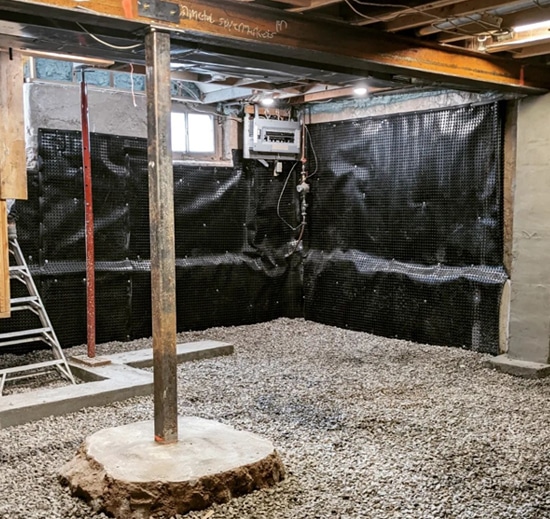
Structural Foundation Repair Toronto & GTA
Do you need top-rated structural foundation repair in the GTA? Find out why GJ MacRae is considered the best in the business for structured foundation repair.
Our Services Are Trusted By








Toronto's Best Structural Foundation Repair Services
No matter how beautiful your home is, if the foundation is not strong, no beautiful renovations to the upper floors will matter in the long run. A robust foundation is a must for any home, and everyone wants that. If you have a foundation crack in your home, don’t worry; you are not the only one. It’s a common problem in Toronto due to several factors, such as significant changes in temperature, clay soil, poor drainage, and the age of properties. Such factors are the leading causes of cracks that weaken your home. Structural foundation repair can be a complex and challenging process with its own potential problems. While it is essential to address foundation cracks issues promptly, homeowners should also be aware of the potential challenges they might encounter during the repair process. While structural foundation repair costs can be a concern, other factors such as structural complexity and hidden cracks should also be considered. It’s crucial to choose an experienced contractor for the job.

The Most Trusted Foundation Repair Company in Toronto
GJ MacRae Foundation Repair is an entirely family-owned basement waterproofing and structured foundation repair company that has provided foundation repair services in Toronto since 1975. We have almost five decades of experience providing basement underpinning and foundation repair services in Toronto. Having served over 10,000+ customers, we are one of Toronto’s best structural foundation repair. Our experienced staff combines the latest tools and repair methods to create an ideal solution for your home.
GJ MacRae Foundation Repair has served The GTA, Hamilton, Etobicoke, Mississauga, Toronto, Oakville, Burlington, Milton, Georgetown, and surrounding areas since 1975. Need structural foundation repair at your home? Call us today!
Why Structural Foundation Repair?
Structural foundation repair addresses and resolves issues or damage to a building’s foundation that affect its structural integrity. When working with structural foundation repair, it’s crucial to identify and rectify problems that may compromise the stability and safety of the entire structure. It typically involves a thorough assessment and analysis of the foundation’s condition by qualified professionals such as structural engineers or foundation repair specialists. They inspect the foundation for signs of damage, such as cracks, settling, bowing, or shifting. Once the issues are identified, appropriate repair methods and techniques are employed to restore the foundation’s stability.
Structural foundation repair is done for several reasons, all of which revolve around ensuring the stability, safety, and longevity of a building. Here are the main reasons why structural foundation repair is necessary:

Restore Structural Integrity
The foundation serves as the base on which the entire home rests, which is why any damage or deterioration in the foundation can compromise the structural integrity of the whole building. Structural foundation repair is performed to restore the stability and strength of the foundation, preventing further damage and ensuring the building’s structural integrity remains intact for decades to come.

Address Foundation Issues
Structural damage foundation problems can manifest in various forms, such as cracks, settling, bowing, or shifting. These issues can arise from soil movement, water damage, inadequate construction practices, or natural disasters. Structural foundation repair is done to address these problems and rectify the underlying issues causing the damage.

Ensure Safety
A compromised foundation poses a safety risk to the occupants of a building. Uneven floors, leaning walls, or shifting structures can lead to accidents and injuries. Basement foundation structural repairs aim to rectify these issues and create a safe living or working environment for the occupants of the building.

Prevent Further Damage
Foundation issues tend to worsen over time if left unaddressed. Cracks can widen, settling can become more pronounced, and structural components can become compromised. Undertaking structural foundation repair prevents further damage. Repairing the foundation in its early stages can help avoid more extensive damage and mitigate potential safety hazards.

Preserve Property Value
The worth of a property is closely linked to the health of its foundation. The occurrence of the basement foundation problem is considered heavily on its estimated value. A solid and stable foundation is essential for maintaining property value. Property owners can preserve and potentially increase the value of their investment by undertaking necessary structural foundation repairs.
How Do We Repair the Structural Foundation?
01
Assessment
We thoroughly examine damaged foundation walls and identify cracks and weaknesses.
02
Excavation
We carefully excavate down to the footings by hand to ensure a comprehensive repair. In some cases, techniques like bench pinning are also used to further stabilize and reinforce foundation walls.
03
Foundation Replacement
Our team expertly removes and fully replaces the old damaged footing and foundation wall.
04
Drainage Enhancement
We waterproof and install a new weeping tile system to the new foundation wall, ensuring adequate water management around your home’s foundation.
Signs of a Bad Structural Foundation: Recognizing Red Flags Early
A solid foundation is essential for any structure’s stability and integrity; identifying signs of a compromised structure can prevent further damage and costly repairs. Remember that your home’s foundation is a critical component of its structural integrity, and any foundation crack repairs should be taken seriously to avoid potential complications down the line, but here are some key indicators to watch out for:

- Cracks in Walls and Floors: Cracks on walls, especially those wider at the top or bottom, can indicate foundation settling or movement. Flooring tiles, hardwood, or concrete can also show cracks or unevenness.
- Uneven Floors and Sloping: Floors that slope or feel uneven when you walk across them suggest that the foundation might sink or shift unevenly. This could impact the overall stability of the building.
- Sticking Doors and Windows: Difficulty opening or closing doors and windows could be due to the foundation shifting, causing misalignment of the frames.
- Sagging or Bowing Walls: Sagging or bowing walls on the interior or exterior indicate foundation issues affecting structural integrity.
- Basement Water Leakage: Water seepage or dampness in the basement can point to foundation cracks, allowing moisture to enter. This can lead to mold growth and weaken the foundation over time.
- Separation of Exterior Elements: Separating porches, decks, or other exterior structures from the main building can indicate foundation movement.
Why Choose GJ MacRae?
- Top Rated Customer Service: Customer satisfaction is our primary goal. That's why we are Toronto’s best dry well and French drain installation contractors. We will work with you closely to understand your needs and provide the best French drain installation solution for your French drain and dry well project.
- Comprehensive Services: With GJ MacRae, homeowners can find all foundation repair solutions under one roof. From foundation crack repair to exterior waterproofing and weeping tile installations, we have the expertise and resources to address your complete waterproofing needs from start to finish.
- Decades of Experience: With nearly 50 years of experience, GJ MacRae is known for french drain and dry well installation experts in Toronto, delivering quality, long-term French drain with dry well solutions in Toronto while tackling even the most challenging projects with confidence and expertise.


Protect Your Foundation
- Value-Based Pricing: GJ MacRae offers value-based French drain with dry well installation service in Toronto without compromising quality. We provide transparent and fair quotes for French drain installation with dry well that ensure homeowners receive the best long-term value.
- High-Grade Materials: GJ MacRae uses high-grade materials combined with the latest French drain installation with dry well techniques, and we are experts in all phases of basement waterproofing. Plus, we are the trusted French drain installers in Toronto and offer innovative solutions that guarantee long-lasting protection against water infiltration.
- Protect Your Investment: When protecting your foundation walls and basement from water damage, choosing GJ MacRae for French drain and dry well installation in Toronto ensures you receive a reliable long-term solution to safeguard your foundation.
Basement Waterproofing and Foundation Repair Projects in Toronto and the GTA
Some Kind Words from Our Customers: Structured Foundation Repair Reviews
Get The Most Out of Your Home With a Structural Foundation Repair in Toronto
Well, it’s not the time to worry about foundation cracks because repairing structural foundation cracks today has never been easier! Repair all hidden cracks troubling your home now, which can be a significant problem in the future. Contact us today for a free consultation. Fill out the form below or contact us at (905) 824-2557 for more information.

Download Our Free eBook
We’re honored to provide these resources to help you on your journey, and we know reputations are hard to build and easy to lose. That’s why our business is built around two simple promises:
Honesty and Transparency.
We genuinely want each step of your journey (from the very first Google search to a leak-free basement) to be positive!

Expert Waterproofing Services for Your Home
GJ MacRae Foundation Repair has been the industry leader for reliable basement waterproofing in the Greater Toronto Area Since 1975. Nearly five decades of experience inform our proven multi-stage repair process based on below-grade drainage considerations that allow us to waterproof concrete blocks, poured walls, and stone rubble foundation walls properly for the long term. Our repair solutions for leaking foundation cracks include using bitumen-based barrier membranes and high-efficiency weeping tile systems, which give us the edge in reliability and allow for the most robust foundation repair warranty available today in the GTA. Experience the GJ MacRae difference for year-round basement leak repairs in Toronto, Oakville, Mississauga, Burlington, Hamilton, Milton, and Georgetown. If you spot cracked foundation walls, leaky foundations, or any other basement waterproofing issues in your house, reach out Wetbasements and call us today at (905) 824-2557.
Quality Foundation Repair Done Right.
What Does quality Foundation Repair Look Like?
RECENT PROJECT PHOTOS
RECENT PROJECT VIDEOS
Our Service Areas
At GJ MacRae, we take pride in extending our services across the GTA to meet our valued customers’ unique needs, and our dedicated team is committed to delivering top-notch solutions all year long. Our expansive service areas are a testament to our unwavering commitment to the highest quality foundation repair services and customer satisfaction in the GTA.
Schedule a Free Consultation Today
Fill out our request form and we will contact you as soon as possible for a free foundation repair consultation!
Frequently Asked Questions
Strengthening a foundation generally requires professional intervention. Steps you can follow to maintain a strong foundation:
- Consult a Structural Engineer: Before making any changes, consult a structural engineer to evaluate your foundation and its current condition.
- Water Management: Proper drainage around your home can prevent water-related issues that weaken foundations.
- Foundation Underpinning: This involves strengthening the foundation by extending it deeper into stable soil.
- Reinforcement Techniques: Techniques like carbon fiber straps or steel braces can be used to reinforce and stabilize foundation walls.
- Proper Maintenance: Regularly inspect and address minor issues to prevent them from becoming significant problems.
The most common causes are soil settlement, clay soils that expand and contract with changes in moisture, improper foundation construction, erosion, and tree root damage. Toronto’s clay-rich soil is prone to movement.
- Cracks in walls and ceilings
- Sticking doors and windows
- Sloping floors
- Gaps between walls and ceilings
- Bowed basement walls and exterior cracks
Costs can differ depending on your home’s size, the extent of the damage, and the foundation repair method used.
Not addressing foundation repairs can lead to increased risks over time. These risks include structural instability, worsening cracks, moisture infiltration causing mold and mildew growth, compromised property value, and potential safety threats for occupants.
The following methods are used for foundation repair:
- Underpinning with steel piers or helical piers.
- Slab jacking or mud jacking.
- Carbon fiber reinforcement for walls.
- Waterproofing solutions such as exterior excavation and drainage systems.
The duration of a foundation repair project can vary significantly based on the extent of damage and the chosen repair method. Minor repairs take a few days, while more extensive projects involving excavation and underpinning could take several weeks to complete.
Expert Waterproofing Services for Your Home
GJ MacRae Foundation Repair has been the industry leader for reliable basement waterproofing in the Greater Toronto Area Since 1975. Nearly five decades of experience inform our proven multi-stage repair process based on below-grade drainage considerations that allow us to waterproof concrete blocks, poured walls, and stone rubble foundation walls properly for the long term. Our repair solutions for leaking foundation cracks include using bitumen-based barrier membranes and high-efficiency weeping tile systems, which give us the edge in reliability and allow for the most robust foundation repair warranty available today in the GTA. Experience the GJ MacRae difference for year-round basement leak repairs in Toronto, Oakville, Mississauga, Burlington, Hamilton, Milton, and Georgetown. If you spot cracked foundation walls, leaky foundations, or any other basement waterproofing issues in your house, reach out and call us today at (905) 824-2557.
Quality Foundation Repair Done Right.
The Original Wetbasements Experts
Serving Toronto and the GTA Since 1975






